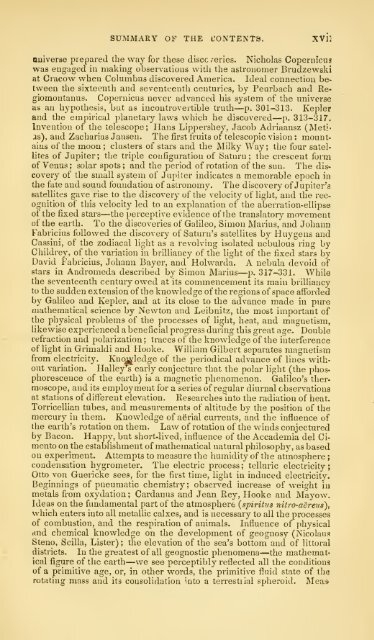See the complete document here
See the complete document here
See the complete document here
Create successful ePaper yourself
Turn your PDF publications into a flip-book with our unique Google optimized e-Paper software.
SUMMARY OF THE CONTENTS. XVli<br />
auiverse prepared <strong>the</strong> way for <strong>the</strong>se discc /eries. Nicholas Copernicus<br />
was engaged in making observations with <strong>the</strong> astronomer Brudzewski<br />
at Cracow when Columbus discovered America. Ideal connection between<br />
<strong>the</strong> sixteenth and seventeenth centuries, by Peurbach and Regiomontanus.<br />
Copernicus never advanced his system of <strong>the</strong> universe<br />
as an hypo<strong>the</strong>sis, but as incontrovertible truth—<br />
p. 301-313. Kepler<br />
and <strong>the</strong> empirical planetary laws which he discovered—<br />
p. 313-317.<br />
Invention of <strong>the</strong> telescope; Hans Lippershey, Jacob Adriaansz (Meti<<br />
as), and Zacharias Jansen. The first fruits of telescopic vision : mounts<br />
aius of <strong>the</strong> moon; clusters of stars and <strong>the</strong> Milky Way; <strong>the</strong> four satel-<br />
lites of Jupiter; <strong>the</strong> triple configuration of Saturn; <strong>the</strong> crescent forai<br />
of Venus; solar spots; and <strong>the</strong> period of rotation of <strong>the</strong> sun. The dis-<br />
covery of <strong>the</strong> small system of Jupiter indicates a memorable epoch in<br />
<strong>the</strong> fate and sound foundation of astronomy. The discovery of Jupiter's<br />
satellites gave rise to <strong>the</strong> discovery of <strong>the</strong> velocity of light, and <strong>the</strong> rec-<br />
ognition of this velocity led to an explanation of <strong>the</strong> aberration-ellipse<br />
of <strong>the</strong> fixed stars— <strong>the</strong> j)erceptive evidence of <strong>the</strong> translatory movement<br />
of <strong>the</strong> earth. To <strong>the</strong> discoveries of Galileo, Simon Marius, and Johann<br />
Fabricius followed <strong>the</strong> discovery of Saturn's satellites by Huygens and<br />
Cassini, of <strong>the</strong> zodiacal light as a revolving isolated nebulous ring by<br />
Childrey, of <strong>the</strong> variation in brilliancy of <strong>the</strong> light of <strong>the</strong> fixed stars by<br />
David Fabricius, Johann Bayer, and Holwarda. A nebula devoid of<br />
stars in Andromeda described by Simon Marius— p, 317-331. While<br />
<strong>the</strong> seventeenth century owed at its commencement its main brilliancy<br />
to <strong>the</strong> sudden extension of <strong>the</strong> knowledge of <strong>the</strong> regions of space atforded<br />
by Galileo and Kepler, and at its close to <strong>the</strong> advance made in piu'e<br />
ma<strong>the</strong>matical science by Newton and Leibnitz, <strong>the</strong> most important of<br />
<strong>the</strong> physical problems of <strong>the</strong> processes of light, heat, and magnetism,<br />
likewise experienced a beneficial progress during this great age. Double<br />
refraction and polarization ; traces of <strong>the</strong> knowledge of <strong>the</strong> interference<br />
of light in Grimaldi and Hooke. William Gilbert separates magnetism<br />
from electricity. Kucu^ledge<br />
of <strong>the</strong> periodical advance of lines without<br />
variation. Halley^ early conjecture that <strong>the</strong> polar light (<strong>the</strong> phosphorescence<br />
of <strong>the</strong> earth) is a magnetic phenomenon. Galileo's <strong>the</strong>rmoscope,<br />
and its employment for a series of regular diurnal observations<br />
at stations of different elevation. Researches into <strong>the</strong> radiation of heat.<br />
Torricellian tubes, and measurements of altitude by <strong>the</strong> position of <strong>the</strong><br />
mercury in <strong>the</strong>m. Knowledge of aerial cuiTents, and <strong>the</strong> influence of<br />
<strong>the</strong> earth's rotation on <strong>the</strong>m. Law of rotation of <strong>the</strong> winds conjectured<br />
by Bacon. Happy, but short-lived, influence of <strong>the</strong> Accademia del Cimento<br />
on <strong>the</strong> establishment of ma<strong>the</strong>matical natui'al philosophy, as based<br />
on experiment. Attempts to measure <strong>the</strong> humidity of <strong>the</strong> atmosp<strong>here</strong> ;<br />
condensation hygrometer. The electric process ; telluric<br />
electricity ;<br />
Otto von Guericke sees, for <strong>the</strong> first time, light in induced electricity.<br />
Beginnings of pneumatic chemistry; observed increase of weight in<br />
metals from oxydation; Cardanus and Jean Rey, Hooke and Mayow.<br />
Ideas on <strong>the</strong> fundamental part of <strong>the</strong> atmosp<strong>here</strong> {spiritus nitro-atireus),<br />
which enters into all metallic calxes, and is necessary to all <strong>the</strong> processes<br />
of combustion, and <strong>the</strong> respiration of animals. Influence of physical<br />
rtnd chemical knowledge on <strong>the</strong> development of geognosy (Nicolaua<br />
Steno, Scilla, Lister) ; <strong>the</strong> elevation of <strong>the</strong> sea's bottom and of littoral<br />
districts. In <strong>the</strong> greatest of all geognostic phenomena— <strong>the</strong> ma<strong>the</strong>mat'<br />
ical figure of <strong>the</strong> earth—we see perceptibly reflected all <strong>the</strong> conditiona<br />
of a primitive age, or, in o<strong>the</strong>r words, <strong>the</strong> primitive fluid state of <strong>the</strong><br />
rotating mass and its consolidation mto a terrestilal spheroid. Mea*
















